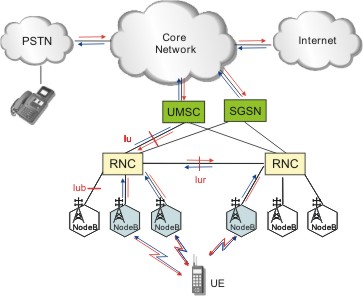CMU (funded by Siemens AG)
Control Mechanisms in the UTRAN (CMU)


CMU Project Team
| Heads | Prof. Dr.-Ing. Phuoc Tran-Gia, Dr. Michael Menth |
| Researchers | Matthias Schmid (infosim GmbH & Co. KG), Prof. Dr. Oliver Rose (formerly with Info3, now with TU Dresden) |
| Partners | Dr. Herbert Heiss (Siemens AG), Thomas Reim (Siemens AG), Prof. Dr. Stefan Schneeberger (formerly with Siemens AG, now with FH Rosenheim) |
| Funded period | October 1999 - September 2001 |
Summary
In this project, we focused on the control mechanisms in the nodes of the Universal Mobile Telecommunication System (UMTR) terrestrial access network (UTRAN). In particular, we studied the following problems:
- The transport layer of the wireline part in the UTRAN is based on AAL2/ATM, i.e., streams of UMTS packets are equipped with an AAL2 header and multiplexed back-to-back into consecutive ATM cells. This works well on a single line, but it requires the switching of AAL2 packets in the UMTS Mobile Switching Centers (UMSC). Thus, we developed fast and scalable hardware algorithms to perform AAL2 multiplexing, ATM cell spacing, and ATM cell multiplexing in a single unit.

- The Radio Network Controller (RNC) schedules the UMTS packets for the transmission over the air interface and sends them over the Iub interface to the NodeB that just transmits the data. Thus, all traffic from the RNC to the NodeB has real-time requirements. However, speech and circuit switched data have even stricter requirements because they should not suffer from packet loss due to delayed data. Thus, the scheduler at the RNC must handle several classes of real-time traffic with different delay requirements. This is basically possible with weighted fair queuing (WFQ) approaches, but the knowledge of the traffic mix is required for its configuration which is usually not available in practice. We developed the Modified Earliest Deadline First (MEDF) algorithm whose single control parameter can be set in an optimal way independently of the traffic mix.
- The transport layer in the wireline part of the UTRAN is based on ATM technology. An AAL2/ATM path is limited to 255 different AAL2 connections. These require a bandwidth in the order 2 Mbit/s. The corresponding ATM connection must be spaced according to this bandwidth for transportation over several network domains although it is carried over a large STM1 trunk. This can lead to significant delay in the order of several milliseconds which is not tolerable as only a small delay budget of 5 ms is allowed for this purpose in the standards. Therefore, admission control (AC) is required for UTMS connections on AAL2/ATM paths. We developed suitable AC admission control algorithms for the multiplexing of speech data compressed by the Adaptive Multirate (AMR) vocoder and circuit switched data.
- The UMSC offers many features, e.g., to mix different call or for lawful interception. This makes the internal bandwidth management of the UMSC more complex and we developed an algorithmic framework to manage that complexity.
Research results of this project were integrated into Siemens products such as


